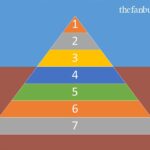In today’s fast-paced world, maintaining a healthy lifestyle has become essential. The Physical Activity Pyramid is a visual guide designed to help individuals understand how to incorporate different types of activities into their daily routines for overall health. One of the most crucial aspects of this pyramid is lifestyle activities, which are often the most accessible and manageable for people of all ages. But where exactly do lifestyle activities belong on the Physical Activity Pyramid? Understanding their placement and importance can help you prioritize these activities for a healthier lifestyle.
What Are Substance-Free Lifestyle ?
Before diving into the placement of lifestyle activities on the Physical Activity Pyramid, it’s important to understand what lifestyle activities are. These are everyday activities that involve physical movement and contribute to your overall well-being. Unlike structured exercises such as running or lifting weights, lifestyle activities are incorporated naturally into your daily life. Examples of lifestyle activities include walking the dog, gardening, cleaning the house, taking the stairs instead of the elevator, or cycling to work.
These activities are essential because they don’t require special equipment or a gym membership, and they can easily be integrated into your routine. Lifestyle activities are ideal for people who may not have the time or resources for more intensive exercise regimens, but still want to stay active.
The Physical Activity Pyramid: An Overview
The Physical Activity Pyramid is a tool that visually represents the types and amounts of physical activity needed for maintaining good health. It is structured like a pyramid, with the most important and frequently recommended activities at the base and more specialized or less frequent activities at the top.
The pyramid is generally divided into four levels:
- Base of the Pyramid: Lifestyle Activities
- Second Level: Aerobic Exercise
- Third Level: Strength and Flexibility Training
- Top Level: Rest and Inactivity
Each level represents different types of physical activities, and the pyramid encourages individuals to incorporate all of these into their routines, with an emphasis on the foundational level—lifestyle activities.
Where Do Lifestyle Activities Belong on the Physical Activity Pyramid?
Lifestyle activities belong at the base of the Physical Activity Pyramid. This means they form the foundation of a healthy, active lifestyle. Since these activities are simple and can be done daily without much planning or effort, they are the most sustainable and accessible form of physical activity. The pyramid emphasizes that lifestyle activities should be performed frequently—ideally, on a daily basis.
Because lifestyle activities are positioned at the base, they are prioritized above other forms of exercise like aerobic activities or strength training. While these structured exercises are essential for comprehensive fitness, lifestyle activities form the core of your daily movement. Without them, it would be challenging to meet the minimum physical activity requirements for maintaining good health.
Why Lifestyle Activities Are at the Base of the Pyramid
The placement of lifestyle activities at the base of the pyramid is no accident. There are several reasons why these activities form the foundation of a healthy lifestyle:
- Accessibility and Inclusivity
Lifestyle activities are accessible to almost everyone. They don’t require any special skills, equipment, or dedicated time, making them a practical option for people of all fitness levels, ages, and backgrounds. Since they can be performed at any time and place, they fit seamlessly into busy schedules. - Consistency Over Intensity
Consistency is key when it comes to physical activity. While intense workouts can have significant health benefits, they are often less sustainable over the long term. Lifestyle activities, on the other hand, can be incorporated into your daily routine with ease. Their consistency means you’re more likely to stick to them, which leads to better health outcomes over time. - Cumulative Health Benefits
Although lifestyle activities may not be as intense as a structured workout, their cumulative effect over the day or week can still yield substantial health benefits. For example, walking for 10-15 minutes several times a day can help improve cardiovascular health, boost metabolism, and support weight management. - Reducing Sedentary Behavior
One of the biggest threats to modern health is a sedentary lifestyle, often caused by long hours of sitting at work or during leisure time. Lifestyle activities help break up periods of inactivity by encouraging movement throughout the day. Simple actions like taking a walk during lunch or choosing to stand while working can significantly reduce the negative effects of prolonged sitting.
Examples of Lifestyle Activities
To better understand where lifestyle activities belong on the Physical Activity Pyramid and how to incorporate them, it’s helpful to consider practical examples. Here are a few common lifestyle activities that can be easily added to your daily routine:
- Walking or Cycling to Work: Instead of driving or taking public transport, consider walking or cycling if the distance is reasonable. This not only contributes to your daily activity but also reduces your carbon footprint.
- Taking the Stairs: Opt for the stairs instead of the elevator or escalator whenever possible. This simple change can increase your daily physical activity significantly.
- Household Chores: Activities like vacuuming, mopping, or gardening may not seem like exercise, but they involve physical movement and can burn calories.
- Walking the Dog: If you have a pet, take them for regular walks. This not only benefits your dog’s health but also ensures you stay active.
- Stretching at Your Desk: If you have a desk job, incorporate standing and stretching breaks into your day. This will help reduce the effects of prolonged sitting and keep your muscles engaged.
The Benefits of Prioritizing Lifestyle Activities
When you prioritize lifestyle activities as part of your daily routine, you’re setting the foundation for a healthier, more active life. Here are some of the key benefits of focusing on lifestyle activities:
- Improved Heart Health: Engaging in regular physical activity, even at moderate levels, can help improve cardiovascular health by lowering blood pressure and improving circulation.
- Weight Management: Lifestyle activities like walking or doing household chores can help burn calories, making it easier to maintain a healthy weight.
- Better Mental Health: Physical activity has been shown to reduce symptoms of anxiety and depression. Regular movement, even in the form of lifestyle activities, releases endorphins that boost mood and reduce stress.
- Increased Longevity: People who stay physically active through lifestyle activities tend to live longer, healthier lives. Their bodies are more resilient, and they are less prone to chronic diseases.
How to Incorporate More Lifestyle Activities Into Your Day
Incorporating more lifestyle activities into your day doesn’t require a complete overhaul of your schedule. Here are some simple ways to add more movement to your daily routine:
- Set a reminder to stand up and stretch every hour if you have a sedentary job.
- Park farther away from the entrance to stores or your workplace to encourage more walking.
- Use part of your lunch break to take a short walk or do some light stretching.
- When watching TV, stand up and walk in place during commercials.
Conclusion
Understanding where lifestyle activities belong on the Physical Activity Pyramid is essential for building a sustainable and healthy daily routine. Positioned at the base, these activities provide the foundation for overall well-being and are crucial for everyone, regardless of age or fitness level. By incorporating simple movements throughout your day, such as walking, gardening, or climbing stairs, you can significantly improve your health and reduce the risk of chronic diseases. Make lifestyle activities a priority, and you’ll build a strong base for a long, healthy life.






